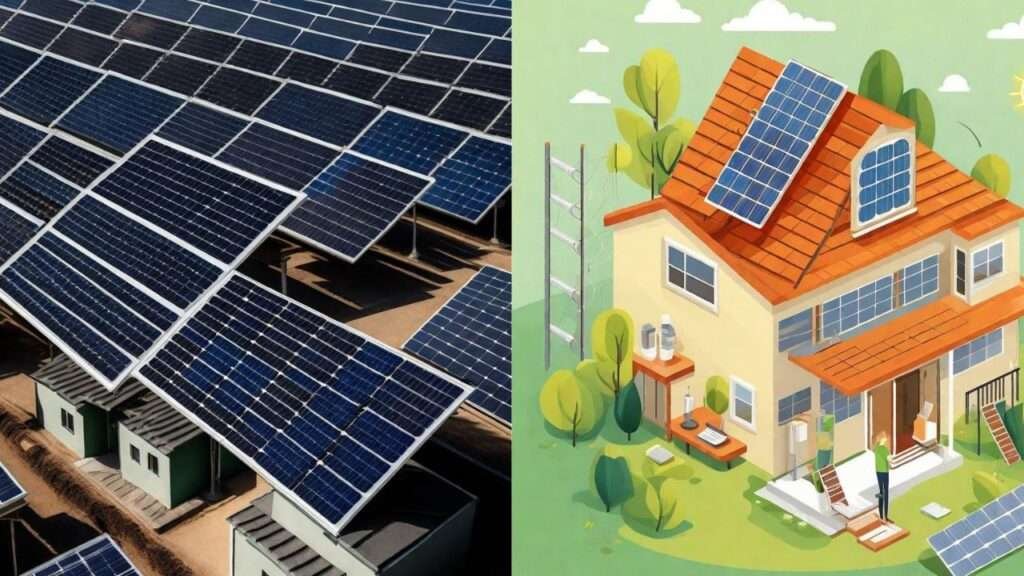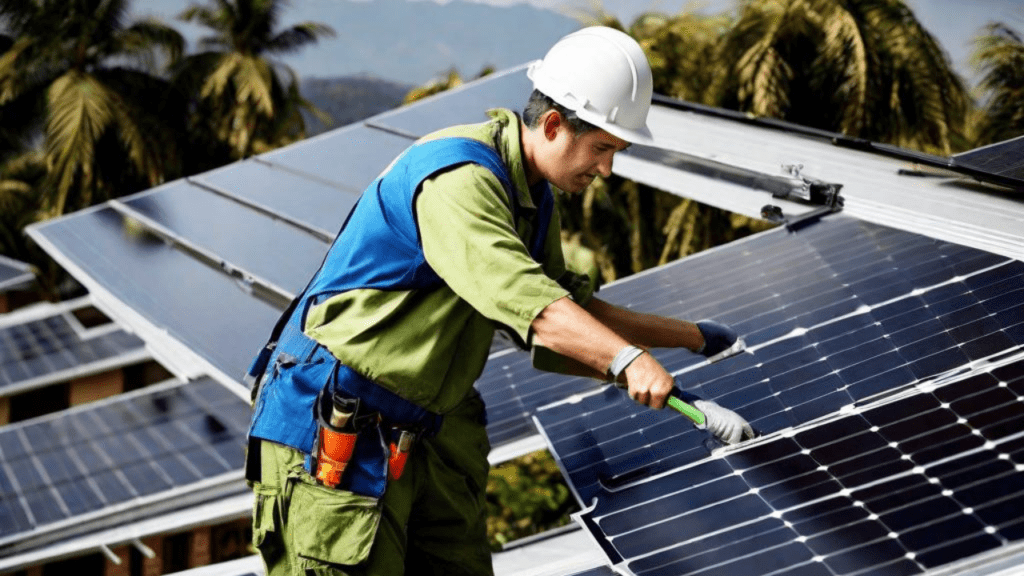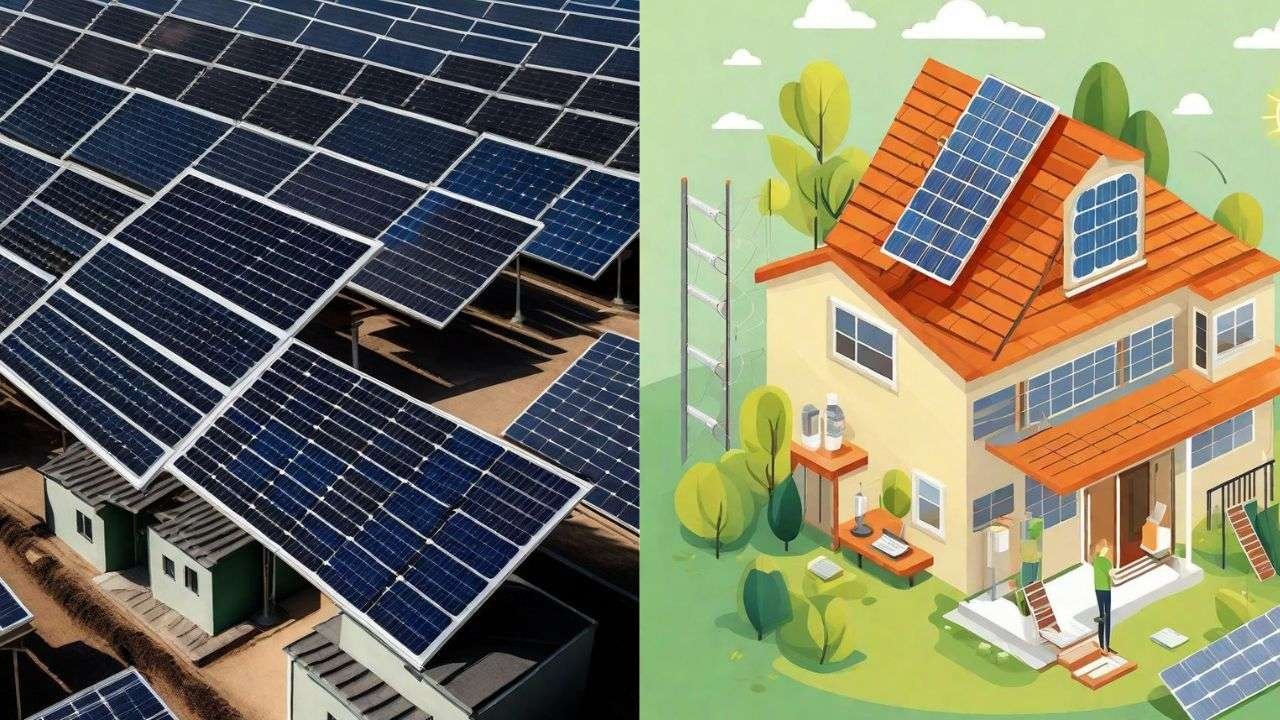
Introduction
Welcome to our guide on the various types of solar panels available in the market today. Solar panels are a popular choice for green energy enthusiasts, helping to reduce carbon footprints and lower electricity bills. Let’s delve into the different types of solar panels and discover which one suits your energy requirements best.
Understanding Types of Solar Panels
When it comes to selecting solar panels for your home or business, it’s essential to understand the key differences between them. The primary factors to consider include efficiency, cost, and aesthetics. Let’s explore four main types of solar panels and their unique characteristics.
Monocrystalline Solar Panels
Introduction
In today’s world, where renewable energy sources are gaining traction, monocrystalline solar panels have emerged as a popular choice for environmentally-conscious individuals. These high-efficiency solar panels offer a range of advantages, making them a viable option for residential and commercial applications.
Understanding Monocrystalline Solar Panels
Monocrystalline solar panels are made from single-crystal silicon, resulting in a sleek black appearance and high efficiency levels. The manufacturing process involves cutting wafers from a single silicon crystal ingot, hence the name “monocrystalline.” This process ensures that the panels can convert sunlight into electricity with minimal energy loss.
Key Features of Monocrystalline Solar Panels:
- High-efficiency rates
- Space-saving design
- Long lifespan
- Superior performance in low-light conditions
Benefits of Monocrystalline Solar Panels
1. Efficiency:
Monocrystalline solar panels are known for their high-efficiency rates, typically ranging from 15% to 22%. This means that they can generate more electricity in less space compared to other types of solar panels.
2. Durability:
These panels are built to last, with most manufacturers offering warranties of 20-25 years. Their robust construction makes them resistant to harsh weather conditions and ensures consistent performance over time.
3. Aesthetics:
The sleek black appearance of monocrystalline solar panels makes them an attractive addition to any rooftop. They blend seamlessly with residential or commercial settings, enhancing the overall visual appeal.
4. Environmental Impact:
By harnessing solar energy, you can reduce your carbon footprint and contribute to a cleaner, greener environment. Monocrystalline solar panels produce clean electricity without harmful emissions, making them a sustainable choice.
Installation and Maintenance

Installing monocrystalline solar panels requires careful planning and professional expertise. It is essential to position the panels in a location that receives maximum sunlight throughout the day to maximize energy production. Regular maintenance, such as cleaning the panels and checking for any damage, can prolong their lifespan and ensure optimal performance.
Conclusion
In conclusion, choosing monocrystalline solar panels for your energy needs is a smart investment in the future. Their high efficiency, durability, and aesthetic appeal make them a compelling choice for residential and commercial applications. By opting for this renewable energy solution, you can enjoy the benefits of clean electricity while reducing your environmental impact. Embrace the power of monocrystalline solar panels today and unlock a sustainable future for generations to come.
Remember, when considering solar panel options, always prioritize quality, efficiency, and long-term benefits. Monocrystalline solar panels offer a winning combination of performance and reliability, making them a top choice for eco-conscious individuals. Start your journey towards clean energy with monocrystalline solar panels and make a positive impact on the planet.
Polycrystalline Solar Panels
Introduction
In today’s world, where sustainability and efficiency are becoming increasingly important, the use of renewable energy sources like solar power is on the rise. One of the key components of a solar energy system is the solar panel, and in this blog post, we will delve into the world of polycrystalline solar panels and explore their benefits and functionality.
What are Polycrystalline Solar Panels?
Polycrystalline solar panels are a type of photovoltaic panel made from multiple silicon crystals. These panels are known for their uniform appearance with a blue hue, making them a popular choice for residential and commercial solar installations. The primary material used in polycrystalline solar panels is silicon, a highly efficient semiconductor material that converts sunlight into electricity.
Advantages of Polycrystalline Solar Panels
- Cost-Effective: Polycrystalline solar panels are known for their cost-effectiveness compared to other solar panel options. This makes them a favourable choice for budget-conscious consumers.
- High Efficiency: While not as efficient as monocrystalline solar panels, polycrystalline panels still offer good efficiency levels, making them a reliable choice for generating solar power.
- Durability: Polycrystalline solar panels are known for their durability and long lifespan, providing consumers with a reliable renewable energy solution that can last for years.
- Versatility: These panels can be used in a variety of settings, from residential rooftops to large-scale solar farms, showcasing their versatility in different applications.
How Polycrystalline Solar Panels Work
Polycrystalline solar panels work by utilizing the photovoltaic effect to convert sunlight into electricity. When sunlight hits the panel, the silicon cells within the panel absorb photons and generate an electric current. This current is then converted into usable electricity through an inverter, which can power homes, and businesses, or even feed excess electricity back into the grid.
Installation and Maintenance
When considering installing polycrystalline solar panels, it’s essential to consult with a professional solar installer to determine the best location and setup for maximum efficiency. Regular maintenance, such as cleaning the panels and checking for any damage, can help ensure optimal performance and extend the lifespan of the panels.
Conclusion
In conclusion, polycrystalline solar panels offer a cost-effective and efficient solution for harnessing solar power and reducing reliance on traditional energy sources. Their durability and versatility make them a practical choice for both residential and commercial applications. By investing in polycrystalline solar panels, you can take a step towards a more sustainable future while enjoying the benefits of renewable energy. Embrace the power of polycrystalline solar panels today!
Thin-Film Solar Panels
Introduction:
In the world of renewable energy, thin-film solar panels have become a hot topic of discussion. As the demand for clean and sustainable energy sources continues to grow, the innovation and efficiency of thin-film solar panels have captured the interest of many. In this blog post, we will delve into the world of thin-film solar panels and explore their potential to revolutionize the renewable energy landscape.
What are Thin-Film Solar Panels?
Thin-film solar panels are a type of solar technology that utilizes thin layers of photovoltaic materials to convert sunlight into electricity. Unlike traditional solar panels, which are made of crystalline silicon, thin-film solar panels use lightweight materials such as cadmium telluride, copper indium gallium selenide, and amorphous silicon. This flexibility in materials allows for thinner, lighter, and more flexible solar panels that can be integrated into a variety of surfaces, including roofs, windows, and even clothing.
Benefits of Thin-Film Solar Panels:
- Cost-Effective: Thin-film solar panels are typically more cost-effective to produce than traditional silicon-based panels, making them an attractive option for large-scale solar projects.
- Flexibility: The thin and flexible nature of these panels makes them ideal for installations on curved or uneven surfaces, expanding the possibilities for solar energy integration.
- Lightweight: Thin-film solar panels are significantly lighter than traditional panels, reducing the structural requirements for installation and making them easier to transport.
- Durability: These panels are less prone to cracking or damage from external factors, increasing their longevity and reliability over time.
How Do Thin-Film Solar Panels Work?
Thin-film solar panels function by absorbing sunlight through their photovoltaic materials, which then generate an electric current. This process is similar to traditional solar panels but with the added benefit of being more efficient in low-light conditions. The thin layers of material allow for a higher energy conversion rate and better performance in cloudy or shaded environments.
Applications of Thin-Film Solar Panels:
- Building-Integrated Solar: Thin-film solar panels can be seamlessly integrated into building facades, windows, and roofs, providing a dual function of energy generation and architectural design.
- Portable Solar Solutions: The lightweight and flexible nature of thin-film panels make them ideal for portable solar applications, such as camping gear, backpacks, and small electronic devices.
- Agricultural Use: Thin-film solar panels can be used in agriculture to provide power for irrigation systems, lighting, and other electrical needs in remote or off-grid locations.
Conclusion:
In conclusion, thin-film solar panels offer a promising solution to the growing demand for clean and sustainable energy sources. Their cost-effectiveness, flexibility, durability, and versatility make them a viable option for a wide range of applications. As we continue to explore innovative ways to harness the power of the sun, thin-film solar panels stand out as a key player in the future of renewable energy. Join the movement towards a greener tomorrow by considering the benefits of thin-film solar panels for your next energy project.
Start your journey towards a sustainable future with thin-film solar panels today!
Bifacial Solar Panels(maximize energy production)
Introduction
In today’s world, where the emphasis on renewable energy sources is growing, bifacial solar panels(4th type of Solar panels) have emerged as a significant innovation in the solar energy sector. These panels offer a way to maximize energy production and efficiency, making them a popular choice for both residential and commercial applications. Let’s delve deeper into the world of bifacial solar panels and explore the benefits they offer.
Understanding Bifacial Solar Panels
Bifacial solar panels are a type of solar panel that can generate electricity from both the front and back sides of the panel. Traditional solar panels only absorb sunlight from the front side, but bifacial panels are designed to capture light that bounces off the ground or surrounding objects. This unique design allows them to generate more power compared to conventional solar panels.
The key feature of bifacial solar panels is their ability to produce energy from both direct sunlight and reflected light. By capturing sunlight from multiple angles, these panels can significantly increase energy output, making them a highly efficient option for harnessing solar power.
Benefits of Bifacial Solar Panels
- Increased Energy Production: One of the primary advantages of bifacial solar panels is their ability to generate more energy compared to traditional solar panels. By capturing sunlight from multiple angles, these panels can produce up to 30% more energy, making them a cost-effective and efficient choice for renewable energy production.
- Enhanced Durability: Bifacial solar panels are designed to be more durable and long-lasting than traditional solar panels. With a robust construction that can withstand various weather conditions, these panels offer a reliable and sustainable energy solution for both residential and commercial applications.
- Improved Aesthetics: The sleek design of bifacial solar panels makes them an attractive option for homeowners and businesses looking to enhance the visual appeal of their properties. These panels blend seamlessly into the surroundings, providing a modern and stylish look while also delivering high energy efficiency.
Installation and Maintenance
When it comes to installing bifacial solar panels, it is essential to consider factors such as orientation, tilt angle, and shading to maximize their energy production. Proper installation by experienced professionals can ensure that the panels function optimally and deliver the highest possible energy output.
In terms of maintenance, bifacial solar panels require regular cleaning to remove dirt, dust, and debris that may accumulate on the surface. By keeping the panels clean and free from obstructions, you can ensure that they continue to operate efficiently and generate maximum energy.
Conclusion
In conclusion, the choice of solar panels depends on your energy goals, budget, and space availability. Monocrystalline panels offer high efficiency, while polycrystalline panels are cost-effective. Thin-film panels provide flexibility, and bifacial panels maximize energy production. Consider your specific requirements before investing in solar panels to optimize your energy savings and environmental impact.
We hope this guide has helped you understand the different types of solar panels available and their benefits. Start your journey towards sustainable energy solutions today!
Related topics
E-NAM- ELECTRONIC NATIONAL AGRICULTURE MARKET
Remember, when considering installing solar panels, research the types that best suit your needs and consult with a professional installer for personalized recommendations.



